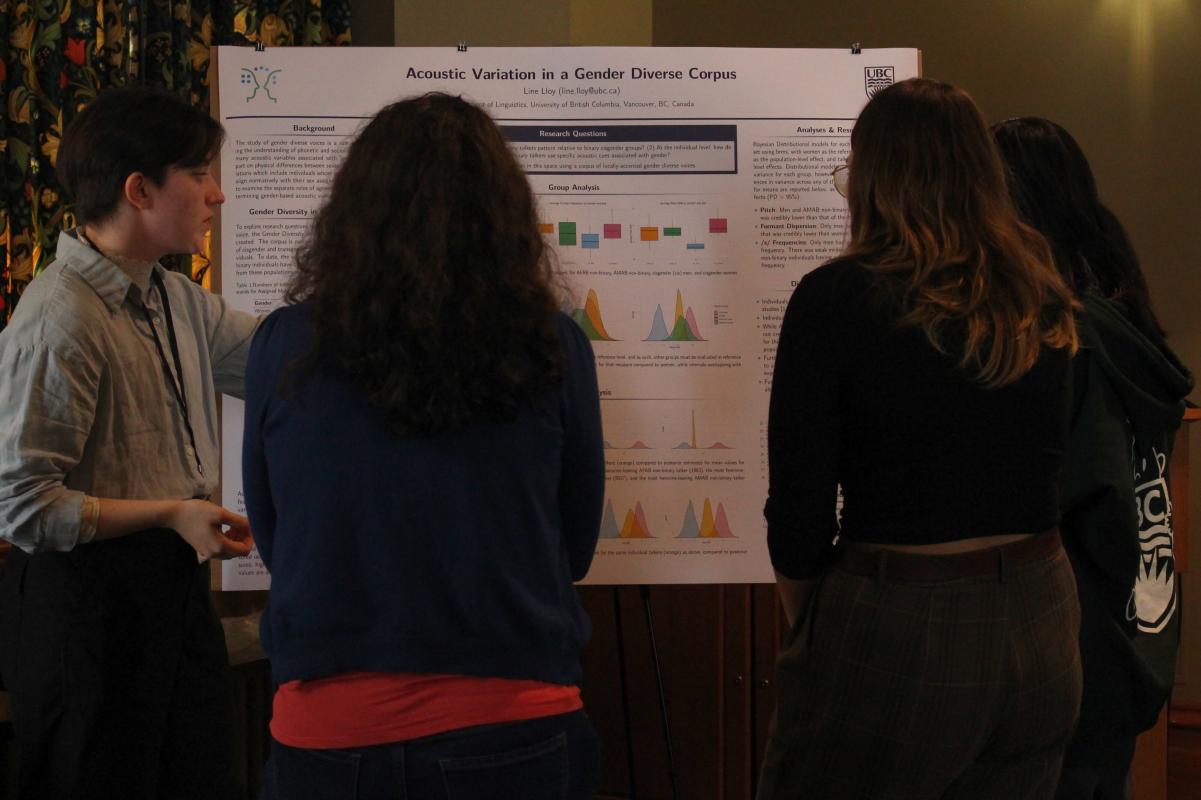Linguistics Masters student Line Lloy has always been interested in speech perception and production, with an informed focus on sounds. While acoustic differences between men and women are often explained as being based in physical differences between sexes, Line knew from personal experience that expressive agency had to play some role as well. This led them to explore acoustic variation in gender diverse groups, where gender identity and physical embodiment don't align in normative ways.
Best Poster Award - Line Lloy (Linguistics, UBC)
Line's study has recently won them the Best Poster Award at Language Sciences' Graduate Student and Postdoctoral Research Day 24'. For those who missed the presentation, here is an overview of their study.
1. Can you briefly describe your research?
My project involves two main components: (1) the establishment of the Gender Diversity in the Voice (GenDiV) corpus, which contains speech from men and women, including transgender and cisgender men and women, as well as non-binary individuals. (2) My Master’s Thesis, which focuses on variation in acoustic features associated with gender. This analysis uses quantitative methods (Bayesian modelling) and qualitative methods (Thematic Analysis) which inform the interpretation of quantitative findings.
2. Most of our readers did not have a chance to study your poster (pity!). Can you describe a few interesting findings for them?
My poster outlined the findings of my quantitative analysis which focused on differences between cisgender men, women, and non-binary groups the corpus in terms of different acoustic variables that have previously been shown to vary according to gender, such as pitch, resonance, and peak /s/ frequencies. The results indicated that /s/ was the measure that non-binary individuals were most able to use to agentively express gender non-conformity as a group. However, it also appears that the non-binary group may be more variable in pitch compared to their cisgender counterparts, which will be explored in further analysis.
3. Your work is studied in relationship with anthropology and queer theories. How do you approach studies outside your field? What are some of the challenges and benefits?
I think it is beneficial to look at where different fields overlap. Luckily, I am far from the first to do this kind of interdisciplinary research; there is a healthy body of literature of research on gender and speech comes from linguists who use anthropological methods, or who apply queer theory. I’ve also taken relevant courses outside my discipline and connected with researchers in other fields who do research with gender diverse populations. Any challenges that come with an interdisciplinary approach are outweighed by the benefits; learning a previously unfamiliar method from outside your discipline, for example, expands your toolkit as a researcher.
An interdisciplinary approach is both beneficial and essential for this project. I don’t want to assume what non-binary individuals’ goals are in terms of gender expression with the voice; I want their perspectives on gender expression to shape how I interpret my quantitative findings. The literature on non-binary voices is still small, and gathering participant perspectives in this way is also an essential step toward formulating better research questions in the future.
4. Is the study still ongoing? If yes, what's next?
Yes! (1) I am still recruiting transgender men and women for the corpus! (2) I am finishing up the qualitative analysis, which explores reasons why non-binary participants would or would not use voice to express gender identity, and (3) the acoustic analysis is being updated to also model within-group variability.
5. In general, what are your research interest(s)? How can people follow your work?
My broader research interests are in speech perception and production generally, with a focus on voice and identity. I will be starting a PhD in Communicative Sciences at NYU in the fall. I will also be sharing a lay summary of my work with participants and other interested individuals when my thesis is complete. To be added to that mailing list, interested parties can send me an email to line.lloy at ubc dot ca.
This article is part of the Graduate and Postdoctoral Research Day series. To read the other interviews, please follow the links below.
Read Q&A with Mariana Pinzon-Caicedo, Honarable Mention Award at Language Sciences' Graduate and Postdoctoral Research Day 24'.
Read Q&A with Starr Sandoval, winner of the Best Talk Award at Language Sciences' Graduate and Postdoctoral Research Day 24'.
